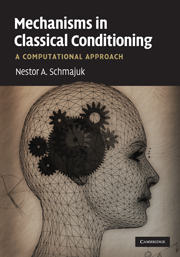Book contents
- Frontmatter
- Contents
- Preface
- Acknowledgments
- Abbreviations
- Part I Introduction
- Part II Attentional and associative mechanisms
- 2 An attentional–associative model of conditioning
- 3 Simple and compound conditioning
- 4 The neurobiology of fear conditioning
- 5 Latent inhibition
- 6 The neurobiology of latent inhibition
- 7 Creativity
- 8 Overshadowing and blocking
- 9 Extinction
- 10 The neurobiology of extinction
- Part III Configural mechanisms
- Part IV Attentional, associative, configural and timing mechanisms
- Part V Conclusion: mechanisms of classical conditioning
- References
- Author Index
- Subject Index
8 - Overshadowing and blocking
from Part II - Attentional and associative mechanisms
Published online by Cambridge University Press: 23 May 2010
- Frontmatter
- Contents
- Preface
- Acknowledgments
- Abbreviations
- Part I Introduction
- Part II Attentional and associative mechanisms
- 2 An attentional–associative model of conditioning
- 3 Simple and compound conditioning
- 4 The neurobiology of fear conditioning
- 5 Latent inhibition
- 6 The neurobiology of latent inhibition
- 7 Creativity
- 8 Overshadowing and blocking
- 9 Extinction
- 10 The neurobiology of extinction
- Part III Configural mechanisms
- Part IV Attentional, associative, configural and timing mechanisms
- Part V Conclusion: mechanisms of classical conditioning
- References
- Author Index
- Subject Index
Summary
In this chapter, we show how the SLG model applies to recovery from overshadowing, the interaction between overshadowing and latent inhibition, recovery from blocking, the inability of a blocked CS to become a blocker of another CS, backward blocking and recovery from backward blocking.
In the last decades, new phenomena have been presented that challenge traditional theories of classical conditioning. Among other observations, Matzel, Schachtman and Miller (1985; Kaufman & Bolles, 1981) established that extinction of the overshadowing CS results in the recovery of the response to the overshadowed CS; Blaisdell, Gunther and Miller (1999) showed that extinction of the blocking CS results in the recovery of the response to the blocked CS; Pineño, Urushihara and Miller (2005) reported that a time delay interposed between the last phase of backward blocking and testing results in the recovery of the response to the blocked CS; Grahame, Barnet, Gunther and Miller (1994) reported that extinction of the context following latent inhibition (LI) results in the recovery of the response of the target CS; De la Casa and Lubow (2000, 2002) demonstrated that a delay interposed between conditioning and testing results in an increased LI effect (super-LI); and Blaisdell et al. (1998) showed that LI and overshadowing counteract each other.
Recovery from overshadowing
In Chapter 3, we mentioned that the competitive rule in the SLG model describes overshadowing (Pavlov, 1927) and relative validity (Wagner et al., 1968). Here we describe recovery from overshadowing, a phenomenon that the model explains in attentional terms.
Information
- Type
- Chapter
- Information
- Mechanisms in Classical ConditioningA Computational Approach, pp. 137 - 164Publisher: Cambridge University PressPrint publication year: 2010
